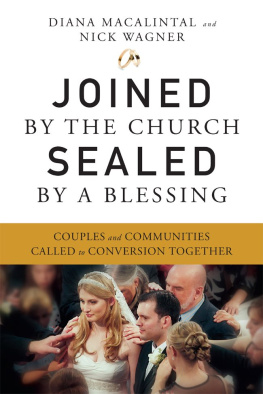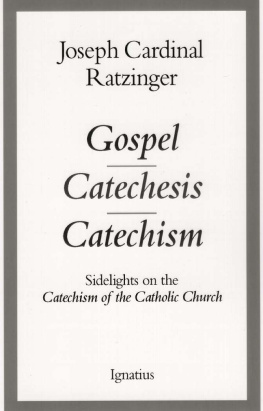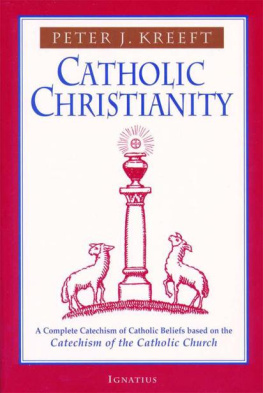National Catholic Educational Association
Creating A
Catechetical Plan:
A How-To-Do-It
Resource
Rev. Robert D. Duggan, S.T.D.
Creating A
Catechetical Plan:
A How-To-Do-It Resource
Rev. Robert D. Duggan, S.T.D.
National Catholic Educational Association
Copyright 2006
National Catholic Educational Association
1005 N. Glebe Road, Suite 525
Arlington, VA 22201
Third Printing 2010
ISBN 1-55833-378-9
Part No. REL-24-1365
Table of Contents
Preface v
Introduction
A Practical Guide to the Planning Process
Phase One: Organize the Planning Process 11
Phase Two: Form the Core Team 16
Phase Three: Assess Your Current Reality 19
Phase Four: Write the Plan 21
Phase Five: Implement the Plan & Evaluate Continually 26
Appendix 1: Planning Worksheets
Planning Worksheet - Goals 31
Planning Worksheet - Objectives 32
Planning Worksheet - Strategies 33
Appendix 2: Sample Plan
Appendix 3: Resources for Core Team Formation
The Churchs Mission of Evangelization as the Context for all Catechesis 41
The Challenge of Inculturating the Gospel Message 42
The Baptismal Catechumenate as the Inspiration for all Catechesis 43
The Primacy of Adult Catechesis 44
The Six Fundamental Tasks of Catechesis 45
Appendix 4: Select Bibliography of Resources
About the Author
Preface
T he National Directory for Catechesis reminds leaders that collaborative catechetical efforts
should not be organized as if they were separate watertight compartments. (NDC p. 256.)
This workbook, Creating a Catechetical Plan: A How-To-Do-It Resource by Robert D. Duggan S.T.D., is the Department of Religious Educations first response to addressing the call for catechetical plans found in the NDC. Hopefully, it will serve as a unifying tool for leaders who are responsible for catechesis at all levels: diocese, parish and Catholic school.
I am indebted to Fr. Duggan for accepting the invitation to create this workbook. In it he shares practical approaches to planning in general and planning for catechesis in particular that are based in sound theory as well as his experience as a pastor.
Many catechetical leaders advised the Department and the author regarding this resource. I wish to thank Dr. Claire Helm, Vice President of Leadership and Operations, Dr. Regina Haney, Executive Director of National Association of Boards, Councils and Commissions and Dan Curtin, Executive Director of the Chief Administrators of Catholic Education at NCEA; Dr. Kathleen Schwartz, Assistant Superintendent of Elementary Schools and Larry Rilla, Diocesan Director of Religious Education in the Archdiocese of Washington, DC; Dr. Timothy McNiff, Superintendent of Schools in the Diocese of Arlington; Fr. Ronald Potts, Pastor of Mother Seton Parish, Archdiocese of Washington, DC; Ted Musco former Parish DRE and Youth Minister, Archdiocese of Washington, DC; Neil Parent, Executive Director of the National Conference for Catechetical Leadership; Dr. Joseph Sinwell, Diocesan Director of Religious Education in the Diocese of Providence; and Daniel Mulhall of the United States Conference of Catholic Bishops. For editorial and production assistance, acknowledgement and thanks go to Christina Gergits and Beatriz Ruiz at NCEA.
Diana Dudoit Raiche
Executive Director
Department of Religious Education
Creating A Catechetical Plan: A How-To-Do-It Resource
Introduction
T he booklet you are holding in your hands is designed to be a very practical resource to help
you fulfill the mandate of the National Directory for Catechesis to develop a systematic plan for
the ministry of catechesis for which you are responsible. Whether you are a pastor, DRE, school principal or diocesan official, you have a clear responsibility to develop such a plan within your area of oversight. Experience has shown that this is a responsibility often met with varying degrees of compliance and success. Clearly, help and encouragement are needed in order to achieve the goal of the NDC that, at every level, our faith communities go about the task of catechesis in a more thoughtful and systematic fashion.
The author chose to title this booklet as a how-to-do-it resource in the hope that this resource might make relatively more manageable what often seems a daunting process. Strategic planning is always hard work, but it can be done smoothly and efficiently, and accomplished in a way that leaves you feeling satisfied with a job well done rather than exhausted and frustrated. Laid out here is a clear, straight-forward process broken into steps that can be followed one at a time. We have avoided making the process too detailed or specific, so that it can be more readily adapted to your specific situation.
Catholic dioceses, parishes and schools have been given a mandate by the National Directory for Catechesis to create a catechetical plan. This resource will be useful to all of these groups, each one making the appropriate adaptations to fit local needs and possibilities. So as not to keep repeating the triad of diocese-parish-school, we will often refer to your community as a shorthand way of referencing the specific level of planning that you will be doing. It is very important that dioceses provide a foundational vision for parishes and schools, and that places a high priority on the diocese to undertake this task as soon as possible. However, we recognize that in some cases the ideal will not be in place, and in those situations parishes and schools will need to do their planning in the absence of a clear set of priorities from the diocese.
The Path of Renewal
In the 40+ years since the close of the Second Vatican Council, the Catholic Church has taken enormous strides on the path of renewal. In virtually every area of our ecclesial life, we have risen to the challenge offered by Pope John XXIII when he asked us to pray (and work) for a new Pentecost in our Church. The field of catechesis has been no stranger to this challenging and difficult task of renewal. In many ways, in fact, the ministry of catechesis has been at the forefront of those efforts to allow the Spirit to lead us toward a more vigorous and dynamic life of discipleship.
In these last forty years we have been led along the path of renewal by visionary and courageous leaders, pontiffs imbued with the evangelical enthusiasm of the Council itself. Pope Paul VI took seriously the mandate of Vatican IIs opening to the world around us, spelled out in the Councils great ecclesiological documents Lumen Gentium , Ad Gentes , and Gaudium et Spes . It was under his supervision that the Rite of Christian Initiation of Adults was published (1972). Several years later, in his Apostolic Exhortation Evangelii Nuntiandi , On Evangelization in the Modern World (1975), Paul VI issued a clarion call for Catholics to bring the message of Jesus Christ to every level of our social reality. The prophetic vision of that document was carried forward tirelessly in what his successor, Pope John Paul II, called the new evangelization.
Building on the wisdom of the last Synod of Bishops to be convoked by his predecessor (1977) to discuss the challenges faced by catechesis today, Pope John Pauls encyclical Catechesi Tradendae (1979) laid out the framework for a renewal of catechesis on the eve of the new millennium. Under his direction, key documents such as the revised Code of Canon Law (1983) as well as the Directory for the Pastoral Ministry of Bishops (Apostolorum Successores, 2004) , focused and highlighted each local bishops primum officium (first responsibility) of preaching the word, particularly by overseeing a revitalization of the ministry of catechesis. His contributions towards a renewal of catechesis culminated, of course, in the publication of the Catechism of the Catholic Church (1994) and the General Directory for Catechesis (1997).












